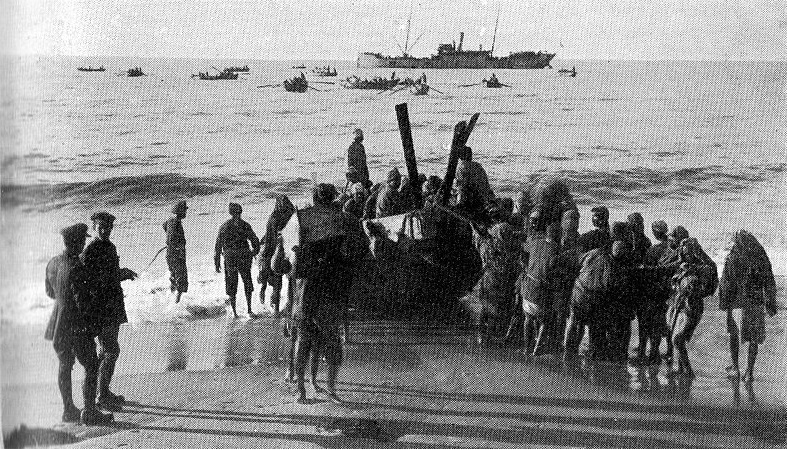 |
| The Amos family. Frank Amos is the young man on the left. |
In her typescript, Aunt Elsie remembered that her uncle Frank Amos was “killed while he was in the infantry, World War No I.” This was one of the instances in which Elsie was less accurate. Frank Amos did, indeed, serve in World War I, but he was not killed in the war.
The service records of the millions of English soldiers who served the WWI were stored in the War Office, which sustained bomb damage during WWII, destroying about two-thirds of the records. But some of the records were salvaged. These are known as the “Burnt Records.” Frank Amos’ record was among these fortunate ones. And it is very lucky for me, indeed, because I owe much of what I know about Frank and his family to these Burnt Records. And, also due to these records, I can trace his service with more completeness than any of my other WWI veterans.
 |
| Firefighters putting out a blaze in London after an air raid during The Blitz in 1941. By New York Times Paris Bureau Collection [Public domain], via Wikimedia Commons |
Frank Amos was called up for service on 2 Mar 1917, and his physical fitness was approved the following day. He reported his age as 30 years and 4 months, and he was 5 feet and 6 ¾ inches tall. His profession in civilian life was “barman,” which is no great surprise. He had been born and raised at a pub, after all. (See my posts on the Creeksea Ferry.) He was married to a woman named Frances Daisy Appleby, whom he had married on the 19th of some month in 1912 (there is a hole burnt through the month; there is a reason these are known as the “Burnt Records”), and they had a son, William George, born 19 Oct 1913.
Frank was posted on 3 Mar 1917 to the 4th Battalion of the Essex Regiment. He is again recorded as being posted to the 4th Essex on 9 Mar 1917. I am uncertain why both dates are recorded, but at this time I still have little experience in deciphering these service records. At any rate, the 4th Essex was crossing the Sinai Desert to participate in the Palestine campaign at the time. It proceeded to engage in all three battles of Gaza. But Frank would have been with them for only the first two, because on 23 May 1917 he was transferred to the 301st Depot of the 5th Labour Battalion.
 |
| Egyptian Labour Corps landing stores near Gaza during World War I By C. Guy Powles (1872–1951) [1][2] [Public domain or Public domain], via Wikimedia Commons |
The Labour Corps was manned in part by soldiers who had been wounded or otherwise rated below the “A1” condition required for front line fighting. Therefore, I have to wonder if Frank had been injured in battle. His Medical History in his service record is difficult to read, much of it apparently having been written in pencil. However, there are a few clues. Under “Slight defects but not sufficient to cause rejection,” which would seem to have been recorded at the time of his enlistment, is written “states trouble with left ankle.” Perhaps the trouble with his ankle had increased and disqualified him. There is also an entry indicating that he had been examined on 4 May 1917. This is a few weeks after the second Battle of Gaza, which would seem to indicate that he was probably not injured in that battle, as he would presumably been examined much sooner. (This is just me making assumptions, though. As stated before, I am no expert on these service records, nor am I particularly knowledgeable about military procedure.) But it is only a few weeks before his transfer to the Labour Corps, so it would seem quite possible that the transfer was a result of the examination. The full entry reads
Examined by No 1. TMG. + placedStrangely, the first line is dark and clear, as though written in pen, but the second line is faded and appears to be in pencil, or at least a lighter shade of ink. Together, though, they would seem to say that he is no longer considered to be in A1 condition, but in B2. In that case, his transfer to the Labour Corps makes sense. But the two different writing materials still confuse me. (I am pondering the effects of the heat of fire on ink, and wondering if that may explain the difficulty in reading some portions of this record.)
in Cat B II.
I have not been able to locate details on the relevant companies of the Labour Corps, so cannot trace with any precision Frank’s movements up to the end of the war. It seems that little research has been done on the companies made up of Englishmen. The Labour Corps also made use of hundreds of soldiers of other ethnicities, in segregated companies, which are beginning to be examined for their historical significance, especially in regard to British colonialism. Without dismissing this important research, I can’t help but selfishly hope that more information on the English units soon appears. All I can currently manage is to list the companies (or as much as could be read of the companies—some of their names were partially burnt) in which Frank served:
Employ Coy, 363Although I could not verify this supposition, I think that “Coy” is an abbreviation for “Company.”
H. S. Emp Coy, 246, 363, 586, 587
Agric Coy, 435
E. C. L. C.
H. S. E. Coy, 583
While Frank was with the 586th or 587th Employment Corps, on 11 Aug 1918, his wife Daisy passed away at the Union Infirmary in Rochford, Essex. Her cause of death was certified as “phthisis,” which is a type of tuberculosis. Frank evidently acquired leave in order to be at her side, as he is the recorded informant on her death certificate. Their son William George would have been a few months shy of five years old. But Frank did not get to stay with his son. The war was not yet over, and Frank had to return to his duty.
 |
| Rochford, Essex, England By Terryjoyce [CC BY-SA 3.0 (https://creativecommons.org/licenses/by-sa/3.0) or GFDL (http://www.gnu.org/copyleft/fdl.html)], from Wikimedia Commons |
He was posted to the 435th Agricultural Coy on 24 Aug 1918, and was apparently serving with them when the armistice was signed. He remained in the Labour Corps, however, moving through two more companies, until 23 Mar 1919, when he was transferred to the East Kent Regiment, the “Buffs.” There appears to be a detailed comment in regard to this transfer, but the ink is so faded I was unable to make out any of it. He was transferred to Class “Z” Army, a reserve contingent of discharged soldiers authorized in case of violations of the armistice, on Christmas Eve of 1919, hopefully just in time to celebrate Christmas with his son.
Sources:
Elsie Crocker, "Elsie Crocker" (typescript, 1990s); copy in possession of Amber Brosius.
England, "Soldiers’ Documents, First World War ‘Burnt Documents’," Frank Amos' enrolment papers, et al; digital images, Ancestry.com Operations Inc, Ancestry (www.ancestry.com : accessed 25 Mar 2011).

